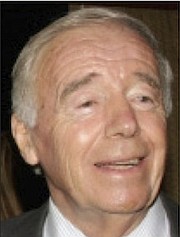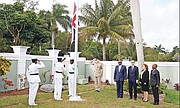A free man at last. Nelson Mandela was released from prison in South Africa 30 years ago. As an anti-apartheid activist and revolutionary, he had become the symbol of opposition to it. Such was the intensity of international interest in him that it was no exaggeration to say that the world watched and waited on February 11, 1990 as he emerged from prison on Robben Island where he had been incarcerated for 27 years. He was serving a life sentence after having been convicted of sabotage at the 1963 Rivonia Trial.
His release marked the beginning of a relatively swift process towards the dream of a unified South Africa with the ending of discrimination on the grounds of race or colour. Mandela himself was elected President in 1994 and, through his leadership, became a global icon in the anti-apartheid struggle. His autobiography ‘Long Walk to Freedom’ published in 1995 has been variously described as a chronicle of one of the remarkable lives of the 20th century and a reminder of man’s ‘indomitable spirit’. It is a compelling memoir which should surely be on people’s ‘must-read’ list.
Having served as a young diplomat in the British Embassy in South Africa during the 1970s, I have to confess to a special interest in the subject. So, briefly, apartheid – defined as the separate and parallel development of people according to their colour and race – was introduced in South Africa by the Afrikaner-dominated National Party following its election victory in 1948. In a nation where whites made up some fourteen percent of the population and owned almost all the wealth including the best land, apartheid developed into a way of protecting their privileges and way of life and of reserving the land for themselves. Black people were stripped of their rights as citizens and their dignity as human beings by being systematically dispossessed of land and homes and forced to provide cheap labour for whites in their designated areas.
Such an iniquitous system imposed by brute force was widely regarded overseas as morally repugnant and was condemned accordingly. It was also opposed by many within the white community in South Africa itself.
While the use of force by the international community to end apartheid was ruled out, tools like sanctions and a sports boycott – which was notably effective, for example, by stopping rugby-mad white South Africans from competing internationally – were deployed. But progress towards overcoming this deeply embedded system of discrimination was gradual, involving both domestic and international pressure – including the Commonwealth Heads of Government meeting in Nassau in 1985 which contributed to that pressure -- on the minority National Party government to begin a meaningful programme of reform. The British government was at the forefront of this, with then Prime Minister Margaret Thatcher engaging in regular direct dialogue with President P W Botha. For example, soon after the Nassau summit she wrote to him urging a public announcement of specific steps towards the ending of apartheid including the release of Mandela. This correspondence was highly classified at the time but can now be found on the internet.
Ultimately, with the emergence of F W de Klerk as President in 1989, the National Party, realising the country’s international isolation had to end, decided to discontinue the policy of separate development, and political leaders developed a vision of a united South Africa by abolishing all forms of discrimination based on race or colour. They accepted the full logical consequences of power-sharing with the black majority and agreed that the opposition African National Congress should be a part of the process as long as this included reasonable protection for minority rights.
A year later most of the apartheid laws were scrapped, Mandela was released and, after extensive negotiations, the first fully democratic elections in South African history took place in 1994.
It is interesting that in his speech immediately after his release Mandela did not call for peace and reconciliation but recommitted the ANC to the armed struggle and called on the international community to continue its campaign to boycott South Africa. Later, however, known for his dignity, courtesy and self-confidence, he became the leading symbol of national unity and the embodiment of the spirit of reconciliation; and, in the words of F W de Klerk, he had an unfailing ability to make ‘just the right gesture at just the right time’, not least when he donned the South African rugby team’s green and gold jersey after its victory in the rugby World Cup on home soil in 1995, thereby winning the hearts of millions of white rugby fans. It was well known that the relationship between Mandela and de Klerk was often fractious as they frequently clashed while working together towards a fundamentally reformed South Africa, but the measure of their efforts was seen in their being jointly awarded the Nobel Peace Prize and the Philadelphia Peace Medal.
While today South Africa may remain deeply divided, with many disillusioned by unfulfilled expectations, Nelson Mandela will surely always be regarded as an icon who played a vital role in bringing about, through a relatively peaceful transition period, a nation of equal rights and opportunities. He was truly a man of the century, who, in writing in typically modest fashion about his Nobel Prize, said that this award was not just about him but was a tribute to all South Africans who had fought in the struggle against apartheid.
Those who perished in Dresden should be commemorated
Another anniversary last week of a more sombre kind was the night and day bombardment of the city of Dresden in eastern Germany 75 years ago by hundreds of US and British planes dropping some 3,500 tons of explosives that turned the area in to a smouldering ruin. This resulted in an estimated 25,000 deaths – mostly older people, refugees, women and children. The attacks took place between February 13 and 15, 1945 in the final stages of the Second World War. This attack on Dresden remains as controversial as the atomic bombing of Hiroshima and Nagasaki preceded by the US firebombing of Tokyo, and it continues to stir deep emotions.
Dresden had always been regarded as one of the world’s most beautiful, ancient cities for its architecture, museums and cathedral and was known as ‘Florence on the Elbe’. It was considered to be an unlikely target for a major Allied air attack - and until that point had been left alone - because its contribution to Germany’s military machine was said to be minimal. The city thus had few defences in the shape of ant-aircraft guns and searchlights. However, the Allies claimed it was a legitimate target because, even if it was not a major industrial centre, it was a key transport junction and its important communications links had to be destroyed. Such bombing in the region was needed as well to shorten the war by reducing pressure on Soviet forces advancing from the east. The city of Dresden was also said to be fanatically pro-Nazi.
Nonetheless, critics condemned the Dresden bombardment as being unjustified militarily since it could have had little real effect on the German war effort so near to the end of the conflict in Europe. They also questioned the action on moral grounds because the Allies had launched ‘area’ and ‘saturation’ bombing that targeted non-combatant civilians to break the morale of the German people. Some continue to argue that the Dresden raids were morally reprehensible because they were designed to slaughter civilians and destroy the architectural and cultural heritage of a great European city.
By contrast, others pointed out that Germany itself had already launched night-time bombing raids on English cities, including London, Coventry, Liverpool and others during the ‘blitz’ from late 1940 to mid-1941 following the Luftwaffe’s defeat by the Royal Air Force in the Battle of Britain. These had resulted in the deaths of 43,000 innocent civilians. There were also the unspeakable atrocities committed by German forces, including concentration camps and the extermination of 6 million Jews together with numberless people forced in to labour camps.
For Britain, the Second World War was first a matter of survival and then of making a supreme effort to secure the unconditional surrender of Nazi Germany. The Allies judged that the only way to ensure the defeat of the enemy was a strategic bombing campaign despite huge losses of aircraft and aircrew and the deaths of German civilians.
It can be argued that, in fighting a moral war against the evil of Nazism and an aggressive Germany which had occupied Czechoslovakia, annexed Austria and then launched an unprovoked attack on Poland, the Allies, in trying to destroy the Third Reich, could still commit what might be considered immoral acts amounting to crimes. But it is equally contended that since Germany initiated the war it should be held morally responsible for the destructive consequences of the Allied use of retaliatory force.
While these issues and arguments remain unresolved, it is interesting that at a ceremonial event in Dresden on February 13 to mark the anniversary of the bombing, Germany’s president called for his fellow citizens to stand up to extremism and nationalism, warning that hatred and a desire for authoritarianism were on the rise again in Europe, including in his own country. He admitted that Germany had started the gruesome and devastating Second World War and could not forget its guilt and responsibility, but those who perished in the Dresden bombings deserved to be commemorated.
I’m glad to see Britain back in business in The Bahamas
I imagine I may not have been the only one with a lump in my throat and a misty eye as two efficient RBDF marines slowly and deftly raised the Union Flag to the top of the flagpole in the garden of the official residence in Nassau of Sarah Dickson, the new British High Commissioner. It was an emotional moment for it signalled formally the re-establishment of a diplomatic mission after a gap of 15 years. Last week’s ceremony - in the presence of the Prime Minister, who spoke of his delight that the High Commission had been reopened, and of the Minister of Foreign Affairs together with invited guests – was a dignified and solemn occasion but also a happy event, with everyone there welcoming a renewed British official presence in The Bahamas. It had always seemed to me, as a former High Commissioner (with two successors before closure in 2005), that the Blair government’s decision to shut a number of diplomatic posts around the world as an economy measure was short sighted and misguided in light of Britain’s worldwide interests; and, following the UK’s departure from the European Union, these have now taken on a new dimension as the nation spreads its wings globally - particularly in the Commonwealth, including an increasing presence in the Caribbean.
The role of British diplomats is to promote and protect the nation’s interests, to support British citizens and to promote trade and investment; and, at the same time, to provide advice and support to government ministers developing UK foreign policy. When posted overseas, it means, in practice, not only conducting the business of the British government with a host country but also becoming involved in every aspect of the relationship between the two countries, working to build bridges and fostering co-operation in many different fields – and, while seeking to promote mutual interests also reconciling conflicting ones. So the remit is broad and the range of activity varied.
A new British official presence in The Bahamas, with an experienced and active career diplomat at the helm, augurs well for future co-operation – and, as the saying goes, the best is surely yet to come.






Comments
Use the comment form below to begin a discussion about this content.
Sign in to comment
Or login with:
OpenID